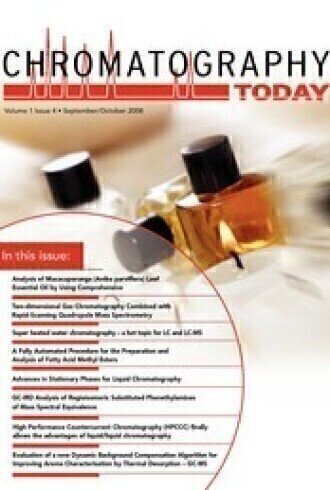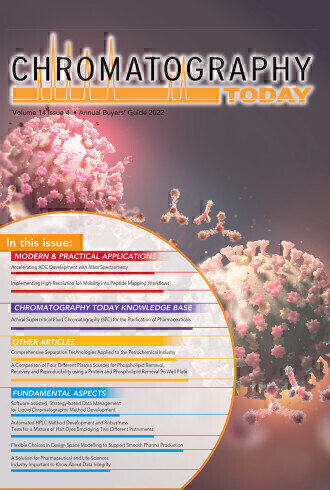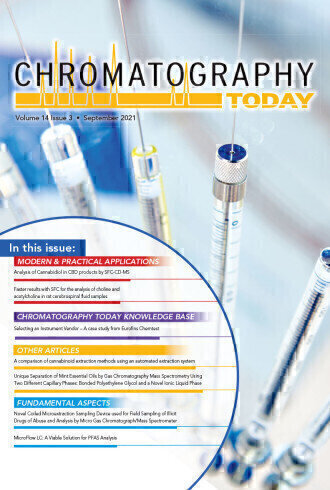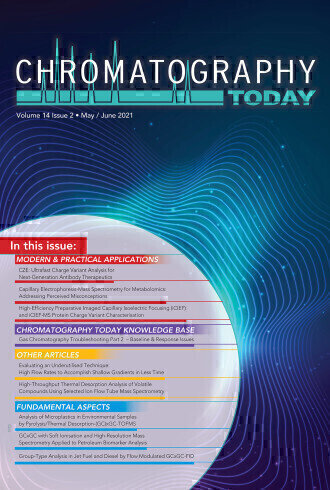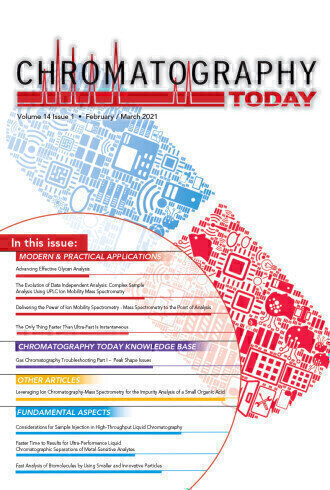Volume 1 Issue 4
Welcome to the fourth edition of Chromatography Today - not quite the first anniversary but we at The Chromatographic Society have been working on Chromatography Today for just about a year now. Chromatography Today is a quarterly publication and as we go into our second year, things will be settling down to a regular pattern of issues in February/March, May/June, August/September and November/December. Thanks very much to authors, advertisers and everyone else who has made a contribution to the first year of our magazine. Thanks particularly go to you our readership. It has been interesting and satisfying to receive your positive feedback.
Before touching on the principal theme of this issue, it would be remiss of me not to look back and reflect on the Chromatographic Society’s Spring Symposium held last May. It might seem quite some time ago now but I am sure that the meeting made a lasting impact on all that attended. As had been anticipated, the meeting proved to be a microcosm of the previous week’s HPLC event in Baltimore. All the boxes were ticked in terms of recent advances in liquid chromatography columns and stationary phases and it was a pleasure for everyone at the Society to be involved at a high quality meeting at which the only problem was managing to squeeze in
everyone who wanted to be there. The standard of presentations was very good and special thanks must go to those such as Ron Majors, Gert Desmet and Roman Kaliszan who took the trouble to visit us from abroad. I hope you enjoy Richard Houghton’s report of the meeting which is included in this issue. The bulk of the content of this issue however involves the well established but highly important field of gas chromatography (GC). The introduction of modern gas chromatography was attributed to Martin and James over fifty years ago in 1952. A natural follow-on from Martin and Synge’s Nobel Prize winning theoretical and partition chromatography work in the early 40’s, GC was also a highly appropriate response to the needs of the time for analysis in the burgeoning petroleum industry. Just as today we have many of the country’s top separation scientists in the major pharmaceutical companies, in the late 1950’s many of the pioneers of chromatography worked for major petroleum companies such as Shell and BP. GC has a much longer practical history than liquid
chromatography (LC) and, with fewer moving parts, it is often regarded as being less costly and more reliable. This technique has become one of the most important and widely applied analytical techniques in modern chemistry, and many scientists claim that it is the most widely applied analytical technique in the world.
There are many who have worked in the field separation for a long time who remember the days early on in their career when they were weaned on GC with great fondness and affection. Two such veteran separation scientist were Ian Wilson (ICI; Zeneca; AstraZeneca) and Mike Cooke (University of Leeds and then Royal Holloway College) whose affection for GC was such that they were driven to form the Pye 104 Club as a sub-section of The Chromatographic Society, the Pye 104 being one of the most popular models of GC in the UK in the “early days”. Remarkably, this was a minor success story, lasting several years and giving rise to some highly informative articles on the early history of GC and on the Pye 104 itself, which appeared in the Chromatographic Society Bulletin. I never joined. I was brought up on the Perkin Elmer F11 and didn’t especially like it. I was always worried that I would not be able to light the flame and also was concerned that if I switched it off incorrectly there would be some suck-back leading to the hydrogen cylinder going up like a rocket! Still I should have been grateful, at least the F11’s inability to give an accurate analysis of isocyanates in black tars led to my introduction to HPLC!! I was interested enough in the F11’s heritage to check it out on the Perkin
Elmer website. There I found a captivating feature on the evolution of Perkin Elmer’s GC instrumentation in which amongst other things I found strong testament to the role of UK pioneers, “In 1953-54, Perkin-Elmer’s representatives heard for the first time about the pioneering GC work done in England, by A.T. James and A.J.P. Martin, in the laboratories of the British Medical Council, London, and by C.S.G. Phillips at the University of
Oxford.” This feature is well worth a read.
However, before I digress any further I must emphasise that the purpose of the GC theme in this issue is not to laud the history of GC but to describe how it has moved on and continues to be a developing field.
There are many major milestones in the development of GC in sample introduction, column technology, and detection modes but the most significant breakthrough was the invention of fusedsilica capillary columns. These have greatly increased the application of high-resolution GC across numerous fields including pharmaceutical, agrochemical and petrochemical industries. As already alluded to earlier, it is probably fair to say
GC is a more robust and rugged technique than its liquid counterpart with the likes of retention time locking being an important advancement in achieving this. While many might say that progress in the field of GC has stalled, progress continues to be rapid in the fields of fast analysis, multidimensional GC and a number of detection techniques. Advancements continue to be made in column technology and it is becoming increasingly possible to analyse the types of molecules that were historically in the liquid chromatography amenable domain. This issue of Chromatography Today will touch on all these areas notably through an article on multidimensional GC-GC/MS from Professor Luigi mondello, an eminent research leader in modern GC and a recent recipient of the Chromatographic Society Jubilee medal. In terms of detection, lowcost, bench-top mass spectrometers have also had a significant impact in the field and two articles exemplifying the utility of these detectors can be found in this Issue 4. Last but not least, let’s mention the article on rapid high temperature liquid chromatography. Yes, this fits in with the theme – let’s just call it Tony Edge’s tribute to the GC oven! We hope you find these articles useful and remember that we are always happy to receive feedback from our readership, whether this be your views on any aspect of separation science or on Chromatography Today itself. Finally I would remind you to keep checking www.chromsoc.com for regular updates on the
Chromatographic Society’s events and also look out for international events. ISC2008 will have just taken place when this issue hits the streets but, on a personal note, look out for PBA2009 to take place in Agra in India between March 1st and 4th. This promises to be a bit different.
Previous Digital Editions
Digital Edition
Chromatography Today - Buyers' Guide 2022
October 2023
In This Edition Modern & Practical Applications - Accelerating ADC Development with Mass Spectrometry - Implementing High-Resolution Ion Mobility into Peptide Mapping Workflows Chromatogr...
View all digital editions
Events
ACS National Meeting - Fall 2024
Aug 18 2024 Denver, CO, USA
Sep 04 2024 Chiba, Tokyo, Japan
Sep 04 2024 University of Warwick, Coventry, UK
Sep 10 2024 Rockville, MD, USA
Plastics Recycling World Expo Europe
Sep 11 2024 Brussels, Belgium
